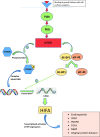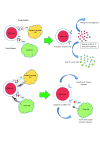Renal cell carcinoma: a review of biology and pathophysiology
- PMID: 29568504
- PMCID: PMC5850086
- DOI: 10.12688/f1000research.13179.1
Renal cell carcinoma: a review of biology and pathophysiology
Abstract
Over the past decade, our understanding of the biology and pathophysiology of renal cell carcinoma (RCC) has improved significantly. Insight into the disease process has helped us in developing newer therapeutic approaches toward RCC. In this article, we review the various genetic and immune-related mechanisms involved in the pathogenesis and development of this cancer and how that knowledge is being used to develop therapeutic targeted drugs for the treatment of RCC. The main emphasis of this review article is on the most common genetic alterations found in clear cell RCC and how various drugs are currently targeting such pathways. This article also looks at the role of the immune system in allowing the growth of RCC and how the immune system can be manipulated to reactivate cytotoxic immunity against RCC.
Keywords: BAP-1; Glutaminase; HIF; Immunotherapy; PBRM-1; VHL; biology; mTOR; renal cell carcinoma; von Hippel Lindau.
Conflict of interest statement
Competing interests: ETL receives kidney cancer clinical trial funding from Argos, Bristol-Myers Squibb, Calithera, Genentech, Merck, Peloton, Pfizer, and Roche; has served as a consultant for Bristol-Myers Squibb; and serves on the Independent Data Monitoring Board for Calithera. ERK receives kidney cancer clinical trial funding from Bristol-Myers Squibb. TWF receives clinical trial funding from Bristol-Myers Squibb, Novartis, Pfizer, Bavarian Nordic, Cougar Biotechnology, Dendreon, GTx, Janssen Oncology, Medivation, Sanofi, Genentech, Roche, Exelixis, Aragon Pharmaceuticals, Sotio, Tokai Pharmaceuticals, Astra-Zeneca/MedImmune, Lilly, Astellas, Agensys, and Seattle Genetics and has served as a consultant for GTx.No competing interests were disclosed.No competing interests were disclosed.
Figures



References
Publication types
Grants and funding
LinkOut - more resources
Full Text Sources
Other Literature Sources
Miscellaneous

